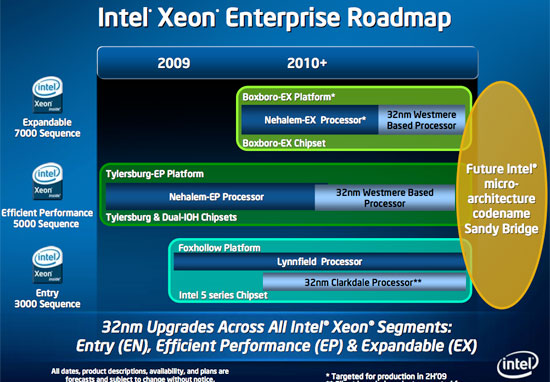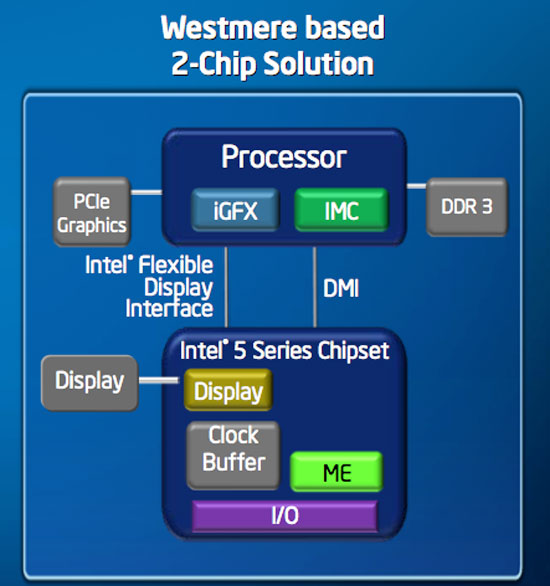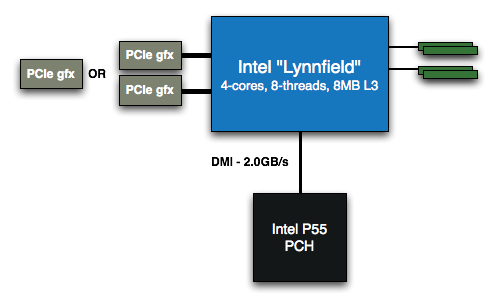Intel's 32nm Update: The Follow-on to Core i7 and More
by Anand Lal Shimpi on February 11, 2009 12:00 AM EST- Posted in
- CPUs
The Server Roadmap
Intel’s 32nm server roadmap is notably different from the desktop roadmap. Nehalem-EX will ship into the Xeon 7000 series as an 8-core, 16-thread part. It will eventually get replaced sometime in 2010 with a 32nm Westmere derivative.

We’ll see a 32nm six-core Westmere based processor in the Xeon 5000 series in 2010.
Finally Lynnfield and Clarkdale will be carried over to the entry level Xeon platforms at the end of this year and into 2010.
What About Chipsets?
Intel’s X58 chipset will remain the top dog through 2010. Chances are that we won’t see it replaced until the next tock with Sandy Bridge. Now that isn’t to say that the six-core 32nm Gulftown will work in existing X58 motherboards; while that would be nice, Intel does have a habit of forcing motherboard upgrades, we’ll have to wait and see.
The rest of the Nehalem/Westmere family will rely on Intel’s upcoming P55 chipset:

Originally both Lynnfield and Havendale were to have an on-package PCIe controller, I’m not sure if that has changed with the Havendale cancellation but I see no reason for it to have. In which case a Lynnfield system will still look like this:











64 Comments
View All Comments
blyndy - Wednesday, February 11, 2009 - link
Let me see if I've got this straight: in 2H'09 (I would actually bet Q3'09) we will finally see the Core i5 quads-cores (Lynnfield/Clarksfield) (on a new LGA-1156 socket), which should have been released in Dec'08.So the 45nm Core i5 quads will be the highest performing CPU available for LGA-1156, positioning above the 32nm Clarkdale/Arrandale dual-cores (the 'Core i5 Duo' maybe?) which arrive in Q4'09
How do they indent to make the LGA-1366 platform have better overclockability, i7 and i5 are almost the same, are they going to actively prevent OC'ing on i5? that would be ridiculous.
Somehow I don't think that the artificial socket segmentation will have a significant number of enthusiast herded into LGA-1366 to get the higher margin cash-cow that Intel has planned it to be.
Triple Omega - Sunday, February 15, 2009 - link
Intel isn't going to artificially limit overclocking directly, but it is indirectly by redirecting the better chips to 1366. So the i7 CPU's will be cherry-picked versions of the i5's and thus will overclock better. Besides that the only socket with Extreme versions will be 1366.(Though that is a niche within a niche really)philosofool - Wednesday, February 11, 2009 - link
Overclockers are a very small fraction of the market. I'm not even sure intel is thinking about overclockability when they engineer chips. Overclockability is more an artefact of good engineering than a design goal from the outset. Overclockers are always paranoid that intel or AMD is out to get them by intentionally crippling chips. There just aren't enough of us for Intel to be concerned. We're like 1% of the total CPU market.Pretty much every chip that intel has released at any price point since the introduction of Core 2 has been wonderfully overclockable. I wouldn't worry that Intel is going to change that soon, especially since Core i5 is basically just mainstream processor with the same design fundamentals as the excellent i7.
JonnyDough - Wednesday, February 11, 2009 - link
Although I understand it's a hobby, I don't care if people can overclock or not. As long as we have fast chips at a good price and they're faster than what we have...I mean, why would you care? Isn't it all about SPEED?ssj4Gogeta - Wednesday, February 11, 2009 - link
i5 probably won't have an extreme version.Bezado11 - Wednesday, February 11, 2009 - link
I wouldn't be surprised if the opposite was true. I'm really sick of all the hype on shrinking creates less heat. Look at the gpu industry, ever since they started shrinking things got hotter and hotter, and now it seems with i7 even though it's not a die shrink and we are use to 45nm by now, the new hardware to support minor changes in architecture of the cpu seem to make things run hotter.I7 is way to hot. The newest GPU's run way to hot.
Lightnix - Thursday, February 12, 2009 - link
But you're making an unfair comparison - for example, the current latest GPUs have only been produced on the newest nodes, ever. Now, if we take for example, a Radeon 3870 vs. a Radeon 2900 XT, the former draws far less power and will overclock better on air, almost directly as a result of them shrinking from a 80nm to a 55nm process, despite them performing exactly the same. Another example is the Core 2 E8000 series and E6000 series. Despite the increase in cache size, the E8000 dissipates little enough heat that they can provide them with a very tiny heatsink compared to the earlier 65nm cores, and objectively they draw much less power at the same clock speed because they run at lower volts.You can see this sort of thing again and again throughout the technology industry, Coppermine (180nm) -> Tualatin(130nm), GeForce 7800 -> 7900, G80 -> G92, etc., etc.
If you were to compare say, a GTX280 to a 8800 GTX and say the former draws much more power than the 8800 GTX, AND it's produced on a smaller process - well, yes, but that's because they've clocked it higher and there are far more transistors (twice as many, in fact).
Mr Perfect - Thursday, February 12, 2009 - link
That's because every time they shrink the chips they pack in new features and push the clock speed to the bleeding edge. If all they did was die shrink the old tech, we'd all be running something like an Atom CPU right now. Atoms closely resemble Pentium 3s, but on modern manufacturing only draw what? 5 watts?V3ctorPT - Wednesday, February 11, 2009 - link
The GPU's run hotter, because they pack double the transistors with a new shrink, than their previous HW... Reduction of the manufacturing process enables that we can have so much more transistors in the same place, of course it gets hot...JonnyDough - Wednesday, February 11, 2009 - link
I think you need to re-read the manufacturing roadmap page. It details the leakage gain (heat).